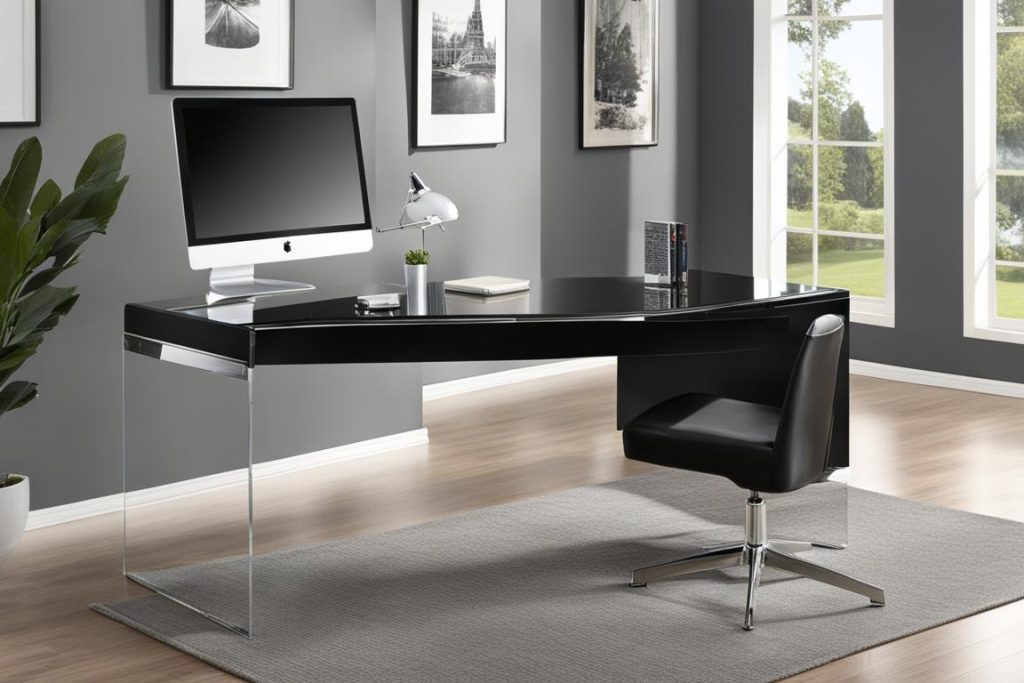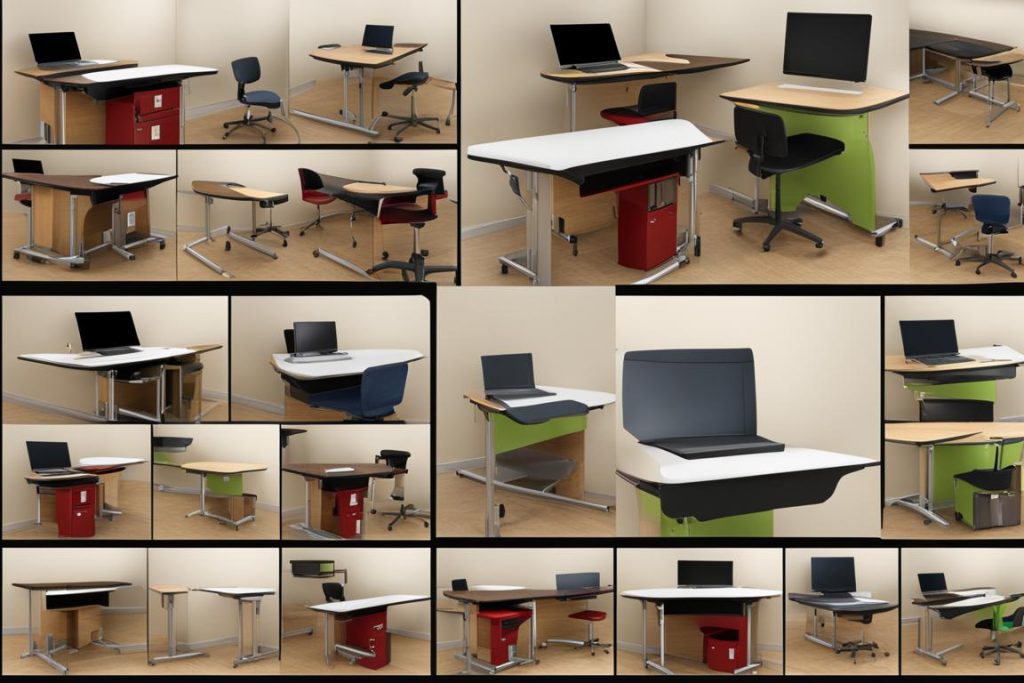Hey there! I’m excited to share some valuable insights about why you need an ergonomic work desk. Trust me, it’s not just a trendy buzzword; it’s all about creating a healthier and more productive work environment.
Think about it – the average employee spends at least 8 hours a day sitting at their desk. That’s a significant portion of their waking hours! Unfortunately, this sedentary lifestyle often leads to work injury complaints and decreased wellness and workplace happiness.
But here’s where an ergonomic work desk comes to the rescue. By investing in ergonomic office furniture that supports good posture and employee well-being, you can reduce pain and work-related injuries. And of course, happier and healthier employees lead to improved productivity and overall workplace satisfaction. It’s a win-win situation!
Why You Need an Ergonomic Work Desk
- An ergonomic work desk promotes good posture and reduces work-related injuries.
- Investing in ergonomic office furniture improves employee wellness and boosts productivity.
- Consider reputable brands and compare features when choosing the right ergonomic work desk.
- Poor desk ergonomics can lead to various health issues, while ergonomic furniture creates a healthier work environment.
- Don’t compromise on employee well-being – invest in an ergonomic work desk and witness the positive impact on productivity and workplace happiness.
Reduces Pain and Boosts Productivity
Ergonomic office furniture, such as chairs and standing desks, plays a significant role in reducing pain and boosting productivity. By improving posture and preventing work-related injuries, ergonomic work desks provide numerous advantages in the workplace.
- Improved Posture: Ergonomic work desks are designed to promote proper alignment of the spine, reducing strain on the back, neck, and shoulders. By encouraging employees to sit or stand in ergonomic positions, these desks contribute to better posture and overall comfort.
- Pain Reduction: With ergonomic work desks, employees can say goodbye to chronic pain caused by prolonged sitting or poor posture. These desks are engineered to support the body’s natural alignment, alleviating strain on muscles and joints and reducing common sources of discomfort.
- Focused Work: When employees are free from pain and discomfort, they can concentrate better on their tasks. Ergonomic work desks create a conducive environment for concentration and productivity, resulting in higher quality work and increased efficiency.
- Increased Energy: Sitting for long periods can lead to fatigue and reduced energy levels. However, ergonomic office desks, particularly standing desks, provide the flexibility to switch between sitting and standing positions. This movement helps improve blood circulation, keeping employees more active and energized throughout the day.
- Enhanced Cognitive Function: Proper ergonomic support contributes to better blood flow, which boosts brain function and cognitive abilities. Employees experience improved mental clarity and focus, leading to enhanced problem-solving skills and creativity.
By reducing pain and discomfort, ergonomic work desks significantly contribute to increased productivity and employee well-being. It is essential for employers to invest in ergonomic office furniture to create a workspace that fosters both physical and mental health.


Improves Employee Wellness
Ergonomic office furniture plays a crucial role in improving employee wellness. By promoting good posture and reducing the risk of musculoskeletal issues, ergonomic work desks contribute to the overall well-being of employees.
Here are some helpful tips for setting up an ergonomic desk:
- Adjust chair height: Set your chair height so that your feet are flat on the floor and your knees are at a 90-degree angle. This helps maintain proper posture and reduces strain on the lower back.
- Use an ergonomic keyboard and mouse: Invest in an ergonomic keyboard and mouse that are designed to support a natural hand and wrist position. This helps prevent repetitive strain injuries and enhances comfort during long hours of work.
- Position the monitor at eye level: Adjust the height of your monitor so that the top of the screen is at or slightly below eye level. This helps reduce neck strain and eye fatigue.
By following these ergonomic desk setup tips, employees can create a workspace that prioritizes their comfort and well-being, ultimately leading to improved productivity and job satisfaction.
For the best ergonomic work desk options, consider reputable brands known for their innovative designs and commitment to ergonomics. These brands offer a range of features such as adjustable height settings, ample workspace, and cable management solutions to create a clutter-free environment.


Investing in an ergonomic work desk is a worthwhile investment for both employers and employees. It not only promotes good posture and reduces the risk of injuries but also enhances overall employee wellness and satisfaction in the workplace.
Choosing the Right Ergonomic Work Desk
When it comes to creating a comfortable and productive workspace, choosing the right ergonomic work desk is essential. By investing in a quality desk that prioritizes ergonomics, you can enhance your overall work experience and improve your health and well-being.
One of the first things to consider when selecting an ergonomic work desk is the brand. Opt for top-rated ergonomic desk brands known for their commitment to providing high-quality and functional products. Some reputable brands to consider include Humanscale, Steelcase, and Herman Miller.
Another important factor to look for in an ergonomic work desk is adjustable height. A desk that offers height adjustability allows you to customize the desk’s position to suit your specific needs. This feature ensures that you can achieve an optimal posture, which is crucial for reducing strain on your neck, back, and shoulders.
In addition to adjustable height, a spacious work surface is also beneficial. A desk with enough space for your computer, paperwork, and other essentials promotes a clutter-free environment and lets you work comfortably. Look for a desk with ample surface area to accommodate all your work materials.
Cable management is another feature to consider when choosing an ergonomic work desk. Excess cables and wires can create a messy and potentially hazardous workspace. Look for desks that provide built-in cable management solutions, such as discreet cable trays or grommet holes, to keep your workspace clean and organized.
Lastly, utilizing a buying guide for ergonomic work desks can be incredibly helpful in making an informed decision. A buying guide provides detailed information about different desk models, their features, and customer reviews. It allows you to compare different options and select the one that best meets your needs.
By considering these factors and utilizing a buying guide, you can choose the right ergonomic work desk that promotes a healthy and productive work environment. Invest in a desk that suits your preferences and work requirements, and enjoy the benefits of improved comfort and well-being throughout your workday.
The Negative Effects of Poor Desk Ergonomics
Poor desk ergonomics can have detrimental effects on your overall health and well-being, leading to a range of issues including vision problems, back and neck pain, as well as wrist, hand, and shoulder pain. It’s important to prioritize your ergonomic setup in order to prevent these problems and create a healthier work environment.
One common issue that arises from poor desk ergonomics is computer vision syndrome. Spending long hours in front of a computer screen can strain your eyes and cause discomfort. Symptoms may include eye irritation, dryness, burning, and blurred vision. By using ergonomic furniture and arranging your workspace properly, you can alleviate these symptoms and reduce the risk of computer vision syndrome.
The Solutions
To create a healthier work environment, consider incorporating the following ergonomic solutions:
- Adjustable monitor height: Position your monitor at eye level to reduce strain on your eyes and neck.
- Ergonomic chair: Invest in a chair with proper lumbar support and adjustable features to maintain good posture and support your back.
- Ergonomic keyboard and mouse: Use ergonomic keyboard and mouse designs that promote natural hand and wrist positions to prevent repetitive strain injuries.
- Wrist rests and mouse pads: Utilize wrist rests and ergonomic mouse pads to provide support and reduce strain on your wrists.
- Monitor glare reduction: Minimize glare on your computer screen by adjusting lighting or using anti-glare filters to protect your eyes from strain and fatigue.
By implementing these ergonomic measures and investing in quality ergonomic furniture, you can create a healthier work environment and decrease the risk of developing musculoskeletal issues and other discomforts associated with poor desk ergonomics.
Conclusion
Investing in an ergonomic work desk is crucial for improving posture, reducing pain, and boosting productivity. With employees spending a significant portion of their day sitting at their desks, having an ergonomic workstation is vital for their overall well-being.
An ergonomic work desk provides numerous benefits, including better support for good posture, reducing the risk of work-related injuries, and minimizing discomfort. By prioritizing employee comfort and health, employers can create a healthier work environment that promotes productivity and job satisfaction.
Furthermore, ergonomic workstations play a key role in enhancing employee wellness. By incorporating features such as adjustable desk height, ergonomic chairs, and proper positioning of computer accessories, employers can significantly reduce musculoskeletal issues and promote overall employee health.
The importance of ergonomic workstations cannot be overstated. From improved posture to increased productivity and employee happiness, ergonomic work desks offer significant advantages for both employers and employees. Investing in well-designed ergonomic furniture is an investment in the well-being and success of your workforce.
FAQ
Why do I need an ergonomic work desk?
An ergonomic work desk is essential for several reasons. It supports good posture, reduces pain and the risk of work-related injuries, and improves productivity and employee wellness.
How do ergonomic work desks improve productivity?
Ergonomic work desks improve productivity by reducing pain and discomfort, allowing employees to focus better and create high-quality work. They also promote good posture and prevent work-related injuries, which can lead to fewer distractions and interruptions.
What are some ergonomic desk setup tips?
To set up an ergonomic desk, make sure to adjust your chair height to support proper posture, use an ergonomic keyboard and mouse, and position your monitor at eye level. These adjustments can help reduce strain on your body and improve overall comfort.
What should I consider when choosing an ergonomic work desk?
When choosing an ergonomic work desk, consider reputable brands known for their ergonomic designs and quality. Look for features like adjustable height, a spacious work surface, and cable management. Using a buying guide can help you compare different options before making a purchase.
What are the negative effects of poor desk ergonomics?
Poor desk ergonomics can lead to various health issues, including vision problems, back and neck pain, and wrist, hand, and shoulder pain. Prolonged computer use can also cause computer vision syndrome, resulting in eye irritation and discomfort. Investing in ergonomic furniture can alleviate these issues and create a healthier work environment.






